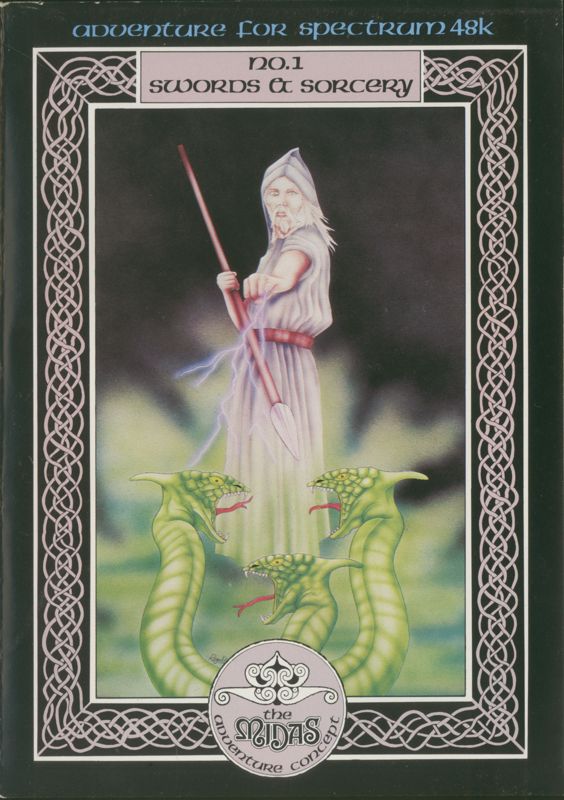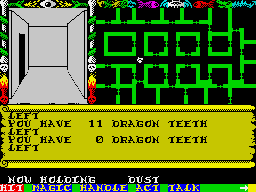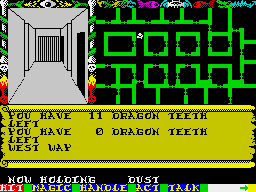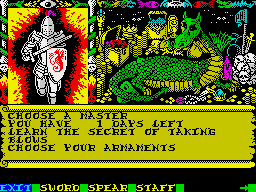Retro Replay Review
Gameplay
Swords & Sorcery opens with a character creation phase that offers both a default party setup and the option to spend up to 14 days training your hero and companions. This initial investment allows you to customize your magic and swordplay skills before taking on the catacombs of Zob. The flexibility in character builds means you can craft a tanky warrior who wades into melee or a glass-cannon mage who relies on powerful spells—each approach shaping your experience as you delve deeper.
(HEY YOU!! We hope you enjoy! We try not to run ads. So basically, this is a very expensive hobby running this site. Please consider joining us for updates, forums, and more. Network w/ us to make some cash or friends while retro gaming, and you can win some free retro games for posting. Okay, carry on 👍)
Once inside the dungeon, the proprietary MIDAS engine presents a first-person view on the left of the screen, accompanied by a detailed map on the right and a scrolling text log below. Navigating the winding corridors requires careful attention to both the visual environment and textual updates: traps can lie in wait around every corner, magical barriers block progress, and teleporters can whisk you back to earlier floors if you’re not paying attention. This blend of visual and text-based feedback keeps every encounter tense and unpredictable.
Combat in Swords & Sorcery is a dynamic affair. Enemies such as Mages, Servants of Set, and Revenant Guardians can be confronted in multiple ways: threaten them into submission, bribe them with stolen gold, or grovel to avoid a fight. Should diplomacy fail, you can draw steel or unleash spells like Un-Poison, Weaken Enemy, and Freeze Enemy. Each spell requires careful testing to understand its effect, adding an element of trial-and-error that rewards experimentation and resource management.
Exploration and inventory management are equally engaging. You’ll collect pieces of the legendary Armour of Zob scattered throughout the catacombs, as well as extra swords, shields, and treasure chests that offer both wealth and gear upgrades. Balancing your party’s spell components, potions, and quest items in the limited inventory space forces you to make strategic decisions about what to carry and what to leave behind.
Graphics
The visual presentation in Swords & Sorcery leans into the classic dungeon-crawler aesthetic, with the MIDAS system rendering crisp, tile-based corridors that evoke early titles like Bard’s Tale. Although the textures are relatively simple by modern standards, the lighting effects—especially in torchlit hallways and magically illuminated chambers—create a compelling atmosphere of mystery and danger.
On the left side of the screen, your first-person view updates smoothly as you move and turn, while the right side hosts a dynamic map that gradually fills in as you explore. This split-screen design is both functional and immersive, allowing you to track your progress without pausing the action. The minimalistic menu bars below keep the focus on the dungeon itself, though you’ll appreciate the occasional animation when invoking spells or engaging in melee strikes.
Character portraits and enemy sprites are rendered with a level of detail that highlights their otherworldly features: Revenant Guardians loom with skeletal armor, Mages flash arcane colors as they prepare spells, and Servants of Set hiss with serpentine eyes. While the overall color palette favors earthy browns and muted grays, bursts of magical hues—icy blues for freeze spells, sickly greens for poison—break the monotony and draw your eye during combat sequences.
Overall, Swords & Sorcery’s graphics won’t challenge high-end 3D titles, but they deliver a cohesive, nostalgic presentation that suits the game’s focus on exploration and tactical play. If you’re a fan of classic first-person dungeon crawlers, the visual style will feel instantly familiar yet polished.
Story
The narrative hook of Swords & Sorcery revolves around the legendary catacombs of Zob, rumored to house untold riches and arcane artifacts. Your party is drawn by the promise of fortune, but soon discovers that the dungeon is steeped in dark magic and guarded by ruthless foes. The backstory of Set—an ancient serpent deity worshiped by twisted cultists—adds depth to the main conflict and provides context for the servants you’ll face.
As you progress, text entries and found scrolls reveal snippets of Zob’s history: once a thriving temple complex, it was corrupted by forbidden rituals that bound Revenant Guardians to its halls. The split Armor of Zob becomes a central quest item, its lore weaving together the ambitions of both heroes and villains. Each new piece you recover deepens the sense of urgency: assembling the armor might grant ultimate power—or unleash a sealed horror.
Character interactions enrich the storyline. Random encounters with NPCs in hidden alcoves offer side quests ranging from rescuing trapped explorers to bargaining for rare spell components. Dialogue choices—whether to threaten, bribe, or grovel—can alter the outcome of these subplots, making the world feel responsive to your decisions. While the overarching plot is familiar to dungeon-crawler aficionados, the method of delivery through in-game texts and environmental clues keeps the narrative engaging.
By the time you confront the high priest of Set in the deepest chamber, the stakes feel personal: you’ve witnessed the horrors of Zob, equipped yourself with its legendary treasures, and honed both blade and spell. The final showdown rewards not just combat prowess but your ability to piece together the dungeon’s lore and exploit its hidden mechanisms.
Overall Experience
Swords & Sorcery strikes a satisfying balance between challenge and reward. The 14-day training option lets newcomers build a capable party without groping in the dark, while veterans can dive straight into default builds for a more immediate test of skill. Encounter difficulty scales appropriately, meaning even experienced dungeon-crawler fans will find themselves on edge when stumbling into an unfamiliar trap or unexpectedly powerful foe.
The interface may feel a bit old-school, but its clarity and responsiveness become strengths as you memorize menu positions and spell commands. The combination of first-person visuals, real-time map updates, and scrolling text creates a rich tapestry of information that keeps you fully immersed in the catacombs. Spell testing, diplomatic options, and looting mechanics add layers of strategy that reward patience and careful planning.
While the graphics won’t wow modern gamers seeking high-end visuals, they perfectly complement the game’s nostalgic charm and focus on gameplay depth. The story is straightforward but well-paced, and the environmental storytelling ensures you’re never simply hacking through corridors without context. Collecting the Armour of Zob pieces and deciphering ancient runes provides both motivation and a tangible sense of progress.
For fans of classic dungeon crawlers and anyone looking for a thoughtful, exploration-driven RPG, Swords & Sorcery delivers a robust and engaging experience. Its blend of character customization, tactical combat, and dungeon lore makes each expedition into Zob’s catacombs feel purposeful, challenging, and rewarding. If you’re drawn to the promise of untold wealth—and willing to face the arcane terrors that guard it—this journey into the depths is well worth your time.
 Retro Replay Retro Replay gaming reviews, news, emulation, geek stuff and more!
Retro Replay Retro Replay gaming reviews, news, emulation, geek stuff and more!









Reviews
There are no reviews yet.